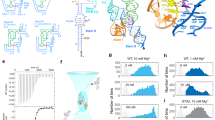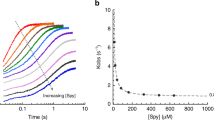Abstract
Protein folding is often described as a search process, in which polypeptides explore different conformations to find their native structure. Molecular chaperones are known to improve folding yields by suppressing aggregation between polypeptides before this conformational search starts1,2, as well as by rescuing misfolds after it ends1,3. Although chaperones have long been speculated to also affect the conformational search itself—by reshaping the underlying folding landscape along the folding trajectory4,5—direct experimental evidence has been scarce so far. In Escherichia coli, the general chaperone trigger factor6,7,8 (TF) could play such a role. TF has been shown to interact with nascent chains at the ribosome9,10, with polypeptides released from the ribosome into the cytosol11, and with fully folded proteins before their assembly into larger complexes12. To investigate the effect of TF from E. coli on the conformational search of polypeptides to their native state, we investigated individual maltose binding protein (MBP) molecules using optical tweezers. Here we show that TF binds folded structures smaller than one domain, which are then stable for seconds and ultimately convert to the native state. Moreover, TF stimulates native folding in constructs of repeated MBP domains. The results indicate that TF promotes correct folding by protecting partially folded states from distant interactions that produce stable misfolded states. As TF interacts with most newly synthesized proteins in E. coli, we expect these findings to be of general importance in understanding protein folding pathways.
This is a preview of subscription content, access via your institution
Access options
Subscribe to this journal
Receive 51 print issues and online access
$199.00 per year
only $3.90 per issue
Buy this article
- Purchase on Springer Link
- Instant access to full article PDF
Prices may be subject to local taxes which are calculated during checkout




Similar content being viewed by others
References
Hartl, F. U., Bracher, A. & Hayer-Hartl, M. Molecular chaperones in protein folding and proteostasis. Nature 475, 324–332 (2011)
Kramer, G., Boehringer, D., Ban, N. & Bukau, B. The ribosome as a platform for co-translational processing, folding and targeting of newly synthesized proteins. Nature Struct. Mol. Biol. 16, 589–597 (2009)
Sharma, S. K., De los Rios, P., Christen, P., Lustig, A. & Goloubinoff, P. The kinetic parameters and energy cost of the Hsp70 chaperone as a polypeptide unfoldase. Nature Chem. Biol. 6, 914–920 (2010)
Dobson, C. M. Protein folding and misfolding. Nature 426, 884–890 (2003)
Bartlett, A. I. & Radford, S. E. An expanding arsenal of experimental methods yields an explosion of insights into protein folding mechanisms. Nature Struct. Mol. Biol. 16, 582–588 (2009)
Hoffmann, A., Bukau, B. & Kramer, G. Structure and function of the molecular chaperone Trigger Factor. Biochim. Biophys. Acta 1803, 650–661 (2010)
Wegrzyn, R. D. & Deuerling, E. Molecular guardians for newborn proteins: ribosome-associated chaperones and their role in protein folding. Cell. Mol. Life Sci. 62, 2727–2738 (2005)
Merz, F. et al. Molecular mechanism and structure of Trigger Factor bound to the translating ribosome. EMBO J. 27, 1622–1632 (2008)
Ferbitz, L. et al. Trigger factor in complex with the ribosome forms a molecular cradle for nascent proteins. Nature 431, 590–596 (2004)
Kramer, G. et al. L23 protein functions as a chaperone docking site on the ribosome. Nature 419, 171–174 (2002)
Agashe, V. R. et al. Function of trigger factor and DnaK in multidomain protein folding: increase in yield at the expense of folding speed. Cell 117, 199–209 (2004)
Martinez-Hackert, E. & Hendrickson, W. A. Promiscuous substrate recognition in folding and assembly activities of the trigger factor chaperone. Cell 138, 923–934 (2009)
Borgia, A., Williams, P. M. & Clarke, J. Single-molecule studies of protein folding. Annu. Rev. Biochem. 77, 101–125 (2008)
Fisher, T. E., Marszalek, P. E. & Fernandez, J. M. Stretching single molecules into novel conformations using the atomic force microscope. Nature Struct. Biol. 7, 719–724 (2000)
Cecconi, C., Shank, E. A., Bustamante, C. & Marqusee, S. Direct observation of the three-state folding of a single protein molecule. Science 309, 2057–2060 (2005)
Fernandez, J. M. & Li, H. Force-clamp spectroscopy monitors the folding trajectory of a single protein. Science 303, 1674–1678 (2004)
Jakobi, A. J., Mashaghi, A., Tans, S. J. & Huizinga, E. G. Calcium modulates force sensing by the von Willebrand factor A2 domain. Nature Commun. 2, 385 (2011)
Junker, J. P., Ziegler, F. & Rief, M. Ligand-dependent equilibrium fluctuations of single calmodulin molecules. Science 323, 633–637 (2009)
Cao, Y., Balamurali, M. M., Sharma, D. & Li, H. A functional single-molecule binding assay via force spectroscopy. Proc. Natl Acad. Sci. USA 104, 15677–15681 (2007)
Bechtluft, P. et al. Direct observation of chaperone-induced changes in a protein folding pathway. Science 318, 1458–1461 (2007)
Bertz, M. & Rief, M. Mechanical unfoldons as building blocks of maltose-binding protein. J. Mol. Biol. 378, 447–458 (2008)
Maier, R., Scholz, C. & Schmid, F. X. Dynamic association of trigger factor with protein substrates. J. Mol. Biol. 314, 1181–1190 (2001)
Kaiser, C. M. et al. Real-time observation of trigger factor function on translating ribosomes. Nature 444, 455–460 (2006)
Lakshmipathy, S. K., Gupta, R., Pinkert, S., Etchells, S. A. & Hartl, F. U. Versatility of trigger factor interactions with ribosome-nascent chain complexes. J. Biol. Chem. 285, 27911–27923 (2010)
Park, S., Klein, T. E. & Pande, V. S. Folding and misfolding of the collagen triple helix: Markov analysis of molecular dynamics simulations. Biophys. J. 93, 4108–4115 (2007)
Hoffmann, A. et al. Concerted action of the ribosome and the associated chaperone trigger factor confines nascent polypeptide folding. Mol. Cell 48, 63–74 (2012)
Han, J. H., Batey, S., Nickson, A. A., Teichmann, S. A. & Clarke, J. The folding and evolution of multidomain proteins. Nature Rev. Mol. Cell Biol. 8, 319–330 (2007)
Jaenicke, R. Stability and folding of domain proteins. Prog. Biophys. Mol. Biol. 71, 155–241 (1999)
Marko, J. F. & Siggia, E. D. Stretching DNA. Macromolecules 28, 8759–8770 (1995)
Thomas, P. D. & Dill, K. A. An iterative method for extracting energy-like quantities from protein structures. Proc. Natl Acad. Sci. USA 93, 11628–11633 (1996)
Acknowledgements
Work in the laboratory of S.J.T. is part of the research programme of the Stichting voor Fundamenteel Onderzoek der Materie (FOM), which is financially supported by the Nederlandse Organisatie voor Wetenschappelijke Onderzoek (NWO). Work in the laboratory of B.B. and G.K. is supported by grants from the Deutsche Forschungsgemeinschaft (SFB 638, FOR967). We are grateful to M. Meyer for his support in performing and analysing FTIR experiments. We thank T. Shimizu, L. Guilbride, M. Dogterom and members of the Tans group for critical reading of the manuscript.
Author information
Authors and Affiliations
Contributions
S.J.T. and A.M. conceived and designed the research; P.B., A.J.M.D. and B.Z.-B. designed and purified the MBP protein constructs; A.M. and P.B. performed the optical tweezers experiments; G.K. and B.Z.-B. purified the TF and MBP truncates and performed the bulk refolding experiments; A.M. and S.J.T. analysed the data; and A.M., G.K., B.B. and S.J.T. wrote the paper.
Corresponding author
Ethics declarations
Competing interests
The authors declare no competing financial interests.
Supplementary information
Supplementary Information
This file contains Supplementary Figures 1-6. (PDF 2317 kb)
Rights and permissions
About this article
Cite this article
Mashaghi, A., Kramer, G., Bechtluft, P. et al. Reshaping of the conformational search of a protein by the chaperone trigger factor. Nature 500, 98–101 (2013). https://doi.org/10.1038/nature12293
Received:
Accepted:
Published:
Issue Date:
DOI: https://doi.org/10.1038/nature12293
This article is cited by
-
Folding pathway of a discontinuous two-domain protein
Nature Communications (2024)
-
Temperature Matters: Bacterial Response to Temperature Change
Journal of Microbiology (2023)
-
The ribosome stabilizes partially folded intermediates of a nascent multi-domain protein
Nature Chemistry (2022)
-
Trigger factor both holds and folds its client proteins
Nature Communications (2022)
-
Mechanism of the small ATP-independent chaperone Spy is substrate specific
Nature Communications (2021)
Comments
By submitting a comment you agree to abide by our Terms and Community Guidelines. If you find something abusive or that does not comply with our terms or guidelines please flag it as inappropriate.



